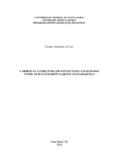| dc.creator | Luz, Gisele Almeida da | |
| dc.date.accessioned | 2021-08-09T18:28:43Z | |
| dc.date.available | 2021-08-09T18:28:43Z | |
| dc.date.issued | 2020-10-30 | |
| dc.identifier.uri | http://repositorio.ufsm.br/handle/1/21851 | |
| dc.description.abstract | This research investigates the theme of death in the works “El hada que quería ser niña” and “El vuelo del ruiseñor” – narratives present in the short story book Tres cuentos de hadas (2003) – by the Spanish writer Gustavo Martín Garzo (1948), and Corda bamba (1981) and Nós três (1988), from the Brazilian writer Lygia Bojunga (1932). The research is comparatist in nature, founded on the death symbolism employed by both authors in their narratives. It gives a brief history of Spanish and Brazilian Children’s and Young Adult literature. Furthermore, questions pertaining to death, as well as fracturing themes, are raised about Children’s and Young Adult Literature such as drug use, sexual abuse, suicide, parental separation and violence. The analysis of symbolic elements relating to death in the fictional works is done using the dictionary of symbols by Chevalier and Gheerbrant (1988). Departing from this analysis, we make the comparison of data in the fictional narratives of Martín Garzo and Bojunga. After the comparatist act, we conclude the importance of addressing hard themes in Children’s and Young Adult fiction, for they help the young reader to assimilate problem situations through reading the fictional text. | eng |
| dc.language | por | por |
| dc.publisher | Universidade Federal de Santa Maria | por |
| dc.rights | Attribution-NonCommercial-NoDerivatives 4.0 International | * |
| dc.rights.uri | http://creativecommons.org/licenses/by-nc-nd/4.0/ | * |
| dc.subject | Literatura comparada | por |
| dc.subject | Literatura infantojuvenil | por |
| dc.subject | Morte | por |
| dc.subject | Simbolismo | por |
| dc.subject | Comparative literature | eng |
| dc.subject | Children’s and young adult literature | eng |
| dc.subject | Death | eng |
| dc.subject | Symbolism | eng |
| dc.title | A morte na literatura infantojuvenil: um diálogo entre Gustavo Martín Garzo e Lygia Bojunga | por |
| dc.title.alternative | Death in children’s and young adult literature: a dialogue between Gustavo Martín Garzo and Lygia Bojunga | eng |
| dc.type | Dissertação | por |
| dc.description.resumo | Este trabalho investiga a temática da morte nas produções “El hada que quería ser niña” e “El vuelo del ruiseñor” – presente no livro de contos Tres cuentos de hadas (2003) – do espanhol Gustavo Martín Garzo (1948), e Corda bamba (1981) e Nós três (1988), da brasileira Lygia Bojunga (1932). A pesquisa é de teor comparatista e tem como base o simbolismo da morte utilizado por ambos autores nas narrativas. Um breve histórico da literatura infantojuvenil espanhola e brasileira é abordado. Além disso, questões referentes à morte na literatura infantojuvenil (LIJ) são levantados, da mesma forma que os temas fraturantes, como drogas, abuso sexual, suicídio, separação dos pais e violência. A análise dos elementos simbólicos referentes à morte nas obras é feita por meio do dicionário de símbolos de Chevalier e Gheerbrant (1988). A partir disso, é realizada a comparação dos dados nas narrativas de Martín Garzo e Bojunga. Após o ato comparatista, concluímos a importância da abordagem de temas duros na LIJ, pois estes auxiliam o jovem leitor a assimilar situações-problema por meio do texto ficcional. | por |
| dc.contributor.advisor1 | Montemezzo, Luciana Ferrari | |
| dc.contributor.advisor1Lattes | http://lattes.cnpq.br/4901993158818284 | por |
| dc.contributor.advisor-co1 | Silva, Vera Lúcia Lenz Vianna da | |
| dc.contributor.referee1 | Calegari, Lizandro Carlos | |
| dc.contributor.referee2 | Cardoso, Rosane Maria | |
| dc.creator.Lattes | http://lattes.cnpq.br/9732575203769443 | por |
| dc.publisher.country | Brasil | por |
| dc.publisher.department | Letras | por |
| dc.publisher.initials | UFSM | por |
| dc.publisher.program | Programa de Pós-Graduação em Letras | por |
| dc.subject.cnpq | CNPQ::LINGUISTICA, LETRAS E ARTES::LETRAS | por |
| dc.publisher.unidade | Centro de Artes e Letras | por |



